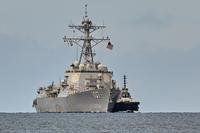Navy and Marine Corps leaders have produced a new 40-page "campaign plan" to better explain to Congress, the public and even members of their own forces why unmanned ships and aircraft are not to be feared.
The Navy Department's Unmanned Campaign Framework was published Tuesday, two days before top leaders are due to testify about the future of drone technology on Capitol Hill.
"This campaign plan reflects an integrated Navy and Marine Corps strategy to make unmanned systems trusted in integral parts of our force," Vice Adm. Jim Kilby, deputy chief of naval operations for warfighting requirements and capabilities, told reporters ahead of its release.
Read Next: Army Chief Hints at New Training Center in Alaska While Unveiling New Arctic Strategy
The sea services' push for funding to test and field unmanned technology -- particularly drone surface vessels -- has faced significant resistance. The Navy wanted $2 billion to build 10 large unmanned surface vessels over the next five years, but later walked that back after lawmakers took steps to block the service from buying any of the ships in 2021 "until a certification regarding technology maturity has been submitted to Congress."
The new campaign plan doesn't include timelines or spending plans for specific platforms since it's unclassified, but explains that unmanned systems will be essential in future fights. Marine Lt. Gen. Eric Smith, deputy commandant for combat development and integration, said every program referenced in the report has a specific timeline with goals to meet their objectives.
The report lists seven unmanned air systems; seven unmanned surface vessels; eight unmanned undersea vessels; and three autonomous ground systems.
Smith said there's an underlying commitment to field the platforms as soon as possible "because the pacing threat is constantly moving and accelerating."
"We feel the proverbial hot breath on our neck to move as rapidly as possible and to be as agile as possible," he said.
Leaders say unmanned systems will be particularly important in competing with China and Russia, but the services aren't just facing resistance to unmanned technology on Capitol Hill. Smith and Kilby cited examples of resistance they see in the fleet, where some are comfortable doing things the way they've always done them.
Marine Commandant Gen. David Berger wrote in the plan that the idea of seeing half the Corps' aviation fleet being unmanned "in the near- to midterm" or most logistics needs being handled by drones should not frighten anyone.
Technology is driving the changes, Smith said, and Marines need to "play our part in it and to maximize it."
"What [the commandant] is saying is for everyone -- for young Marines, for commanders, for the retired community -- is 'Don't be frightened by the fact that you may have a larger percentage of your aviation community be unmanned or that you may have unmanned systems on the ground,'" Smith said. "And frankly, even to the public who we serve, these systems that we are procuring are remotely operated on their way to autonomy."
The goal is to create a hybrid force, Kilby and Smith stressed, in which unmanned platforms support sailors and Marines in the fleet. Pilots or ship drivers shouldn't be concerned they won't be as promotable as the Navy shifts to unmanned platforms, Kilby said. And Marines and sailors will still be making decisions to use lethal weapons on unmanned systems, Smith said.
The Navy and Marine Corps will hold fleet exercises during which troops will have a chance to get familiarized with some of the new systems. One of those exercises will be hosted next month by U.S. Pacific Fleet, Kilby said.
The document says the sea services want to take a "capabilities-based approach" to identify systems that work on a host of platforms rather than building plans around one piece of equipment.
At least one member of Congress already pushed back against the idea though, saying the Navy must address technical and operational problems on new vessels before they enter full production.
"[We] have been here before, rushing into the full development and production of a promising new platform too soon," Rep. Rob Wittman, a Virginia Republican and ranking member of the House Seapower and Projection Forces subcommittee, said Tuesday after the report was published. "It always proves a costly mistake, and we cannot afford to make that same mistake again."
Unmanned systems are "here to stay," Wittman added, calling it exciting to see the new processes underway.
"But we must focus on getting this right rather than doing this too quickly," he said. "... Simply put, the Navy must show they can meet the critical milestones and understand these platforms' roles before we invest taxpayer money into the vessels' full production."
-- Gina Harkins can be reached at gina.harkins@military.com. Follow her on Twitter @ginaaharkins.
Related: The Navy Is Preparing for a Major Unmanned Battle Test in the Pacific













